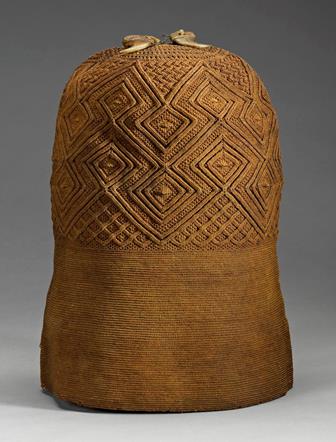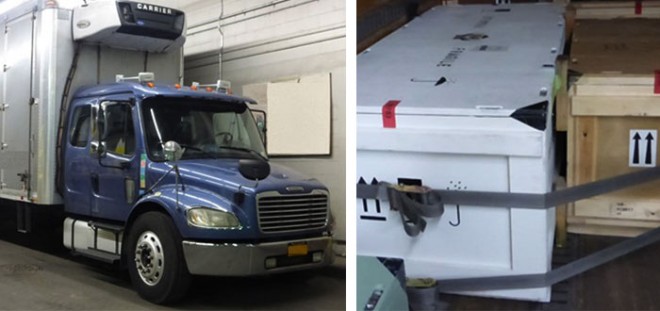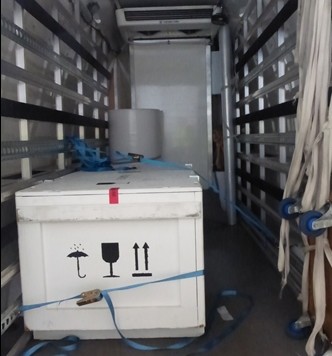I was pleased to be called up to courier some museum objects back to the National Museum of Scotland from the Metropolitan Museum of Art in New York.
Five objects in total had been lent to the ‘Met’. Three ancient Egyptian objects were on display in the exhibition ‘Ancient Egypt Transformed: The Middle Kingdom’ and two African textiles from the Democratic Republic of the Congo had been lent to ‘Kongo: Power and Majesty’. Previous blogs have been written on the Egyptian objects, particularly the golden catfish, which has proven very popular both here and in the States.
As many museum objects are irreplaceable, a legally binding loans agreement is drawn up between the Registrars departments of both museums.

For loans between museums, a representative of the lending institution sometimes travels to see the object installed and de-installed. I was the representative from National Museums Scotland sent to de-install and pack up these objects, and accompany them at all times as they flew back home across the Atlantic.
Heavy blizzards were forecast for the day I was due to arrive in New York, so there was a bit of added drama as my flight was hastily rearranged for a day earlier. I arrived to find cars covered in snow drifts at the side of the road, and a thickly blanketed monochrome Central Park, which was chilly but beautiful to walk across in the morning.

During any exhibition de-installation the gallery is always a flurry of organised movement and people doing specific jobs, and in a large institution like the Met this is particularly true. Teams of people wearing different uniforms specifically open display-cases, remove objects or mounts, control lifting equipment or pack crates. There is inevitably a bit of waiting around, but this is a good opportunity to meet colleagues from other lending institutions, and to see what is left of the exhibition, as it is taken down before your eyes.
The three Egyptian objects from National Museums Scotland collection were de-installed and individually examined against conservation photographs, to make sure there had been no changes or damage whilst they were on display. They were packed away into cut-outs of inert packaging material plastazote in a large wooden crate, together with the two African textiles which had been stored securely elsewhere. The crate itself was secured and marked to signify that it had been inspected by a representative of the Met, so had no need to be re-opened at customs.
With up to 30 exhibitions a year the Met continually has objects arriving and moving around the building. The corridors behind the galleries have regular signs saying ‘Give way to art’, as crates and pallets of paintings and objects, as well as merchandise, catering, cleaning equipment and staff, travel efficiently around the winding subterranean passageways. The National Museum of Scotland has its own share of winding underground corridors, but the Met’s were considerably busier!
I managed to visit the permanent World Cultures galleries in the Met, as well as some of the displays of Modern and American art. It is a huge museum, with many amazing artefacts on display. Particularly memorable exhibits include reconstructed Egyptian tombs and the Temple of Dendur , and open storage of thousands of amulets, scarabs and pot sherds. The galleries of Oceanic art are also very impressive!

All too soon it was time to start the long journey back to Scotland. Seven British couriers travelled back together, so we all watched our crates being securely loaded onto the truck to the airport. Then, in a massive airfreight warehouse, they were wrapped in plastic and tied together on pallets.

The crates were then loaded onto the plane, and we met them again at Heathrow, where the paperwork for customs was completed. One of the African textiles was a cap of finely woven pineapple fibre decorated with leopard claws, so had additional need for a CITES declaration (Convention on International Trade in Endangered Species of Wild Fauna and Flora).

The Scottish vehicle set off first, with the crate securely tied in the back and me nodding off in my seat after the overnight flight. Several hours later we arrived in Edinburgh, and unloaded the crate into secure storage. The objects were then unpacked and checked again by conservators to ensure nothing untoward had happened during their journey. They have now been returned to secure storage, awaiting future research or possibly display in the new Egyptian gallery one day in the future.

